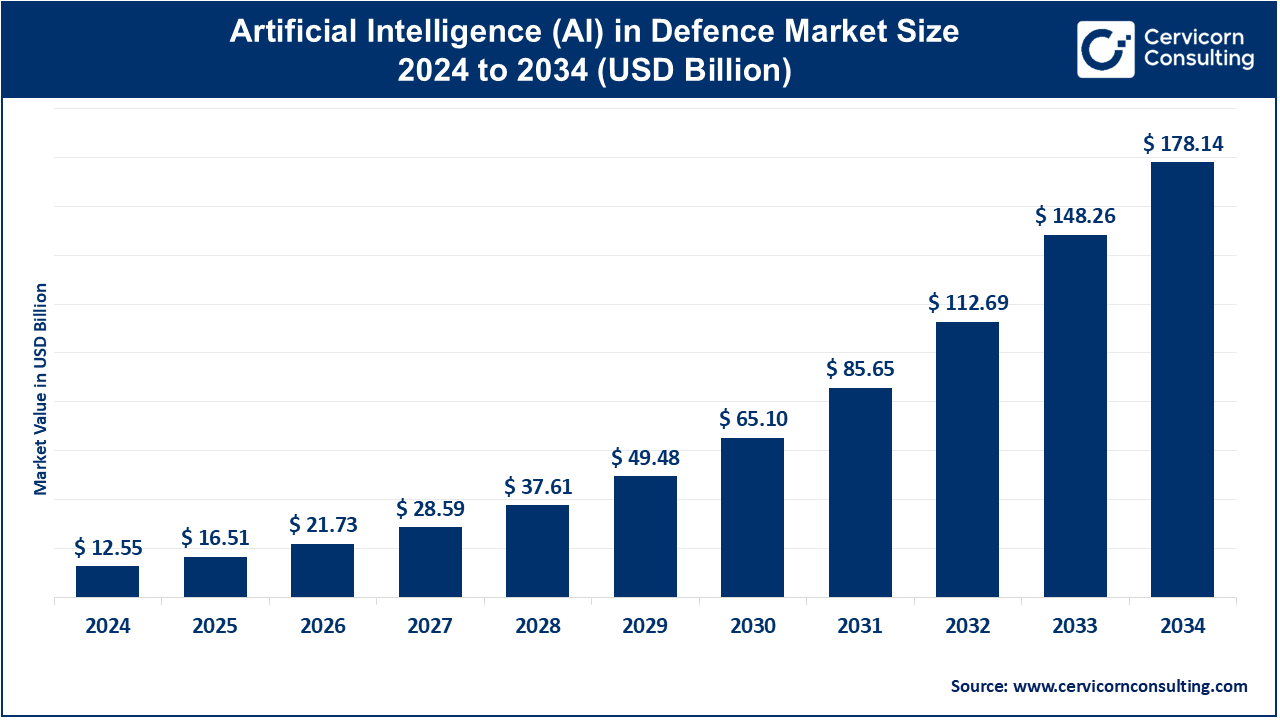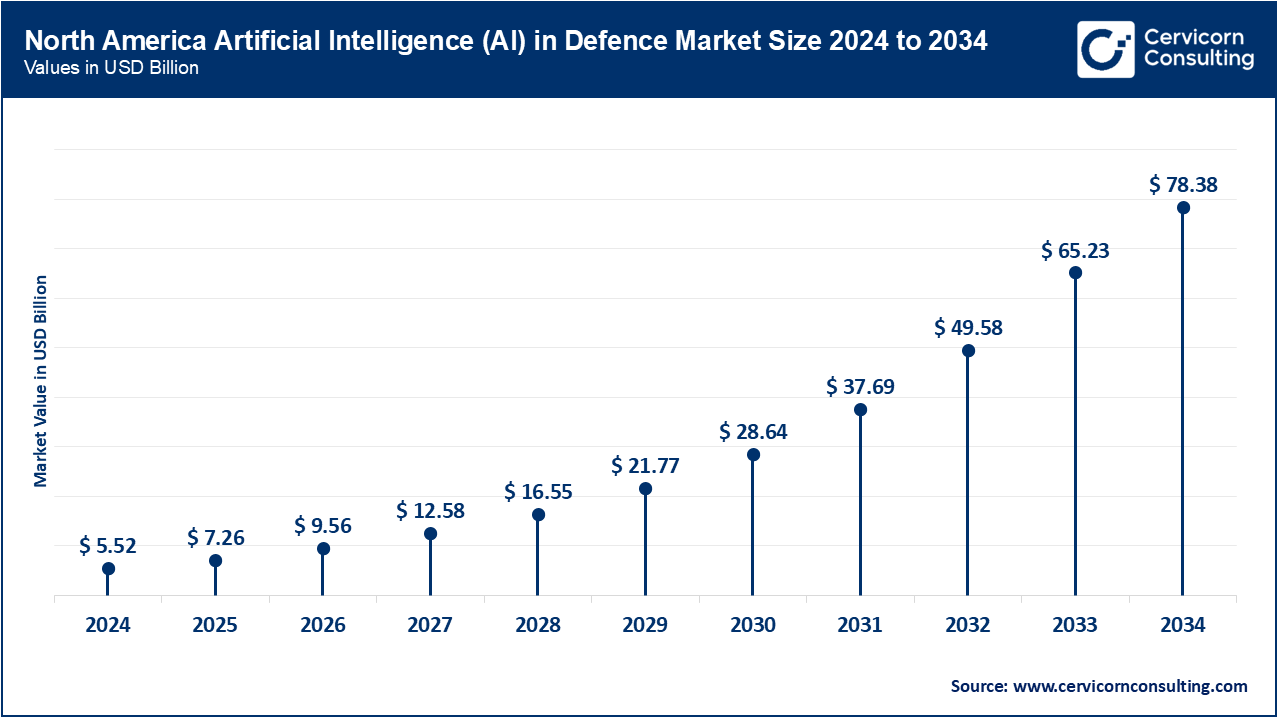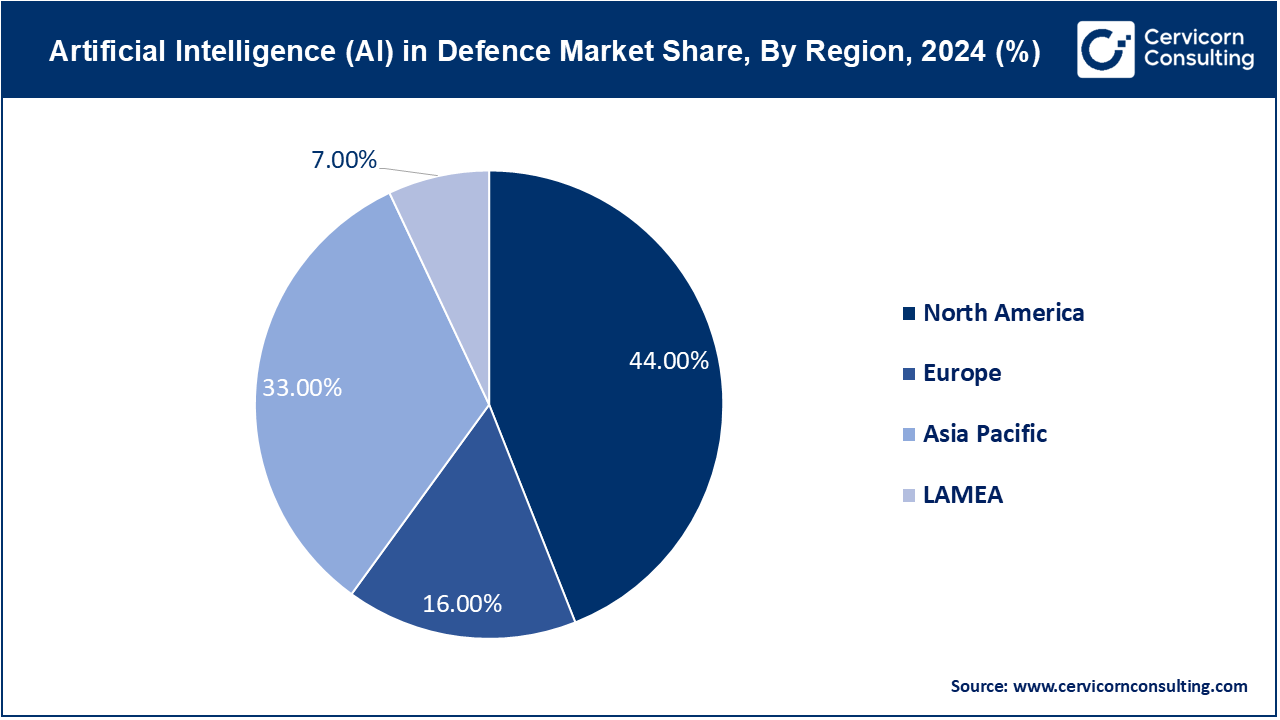The global artificial intelligence (AI) in defence market size was valued at USD 12.55 billion in 2024 and is expected to be worth around USD 178.14 billion by 2034, growing at a CAGR of 30.38% from 2025 to 2034.
The market for artificial intelligence (AI) in defense is experiencing significant growth due to advancements in technology and increasing military investments. As nations strive to gain a technological edge, the demand for AI-based solutions such as autonomous weapons, drones, and cybersecurity systems is on the rise. The integration of AI into defense systems allows for improved decision-making, operational efficiency, and enhanced situational awareness. With rising global security concerns and the need for advanced defense capabilities, governments are increasing their budget allocations toward AI research and development in defense. For example, in 2020, the U.S. Department of Defense allocated around USD 1.5 billion specifically for artificial intelligence (AI) and machine learning (ML) investments. This has led to significant market expansion, with more defense contractors and tech companies entering the AI-driven defense sector. In the coming years, the AI in defense market is expected to continue its upward trajectory. Innovations such as AI-powered predictive maintenance, cyber defense systems, and advanced AI-assisted surveillance are driving this growth.

AI in defence is the incorporation of artificial intelligent technologies in the military and defense to support, facilitate and automate decision makings and the improvement of defense structures. These are; AI used in lethal autonomous weapon systems, surveillance, cybersecurity, logistics, and threats detections. It is worth expanding the market role as it is widely realized that AI technologies are effective for the transformation of militaries on the global level. AI is a kind of computing system which is especially capable of improving as we feed it data and the more the data it receives the more able it is in recognizing patterns.
Integrating AI in the military is revolutionizing defence operations in line with the role of augmenting capacity in different domains of operations such as surveillance, autonomous systems, cyber-defense and logistics. Advanced automation technologies of artificial intelligence including machine learning, computer vision and robotics are being incorporated in military systems for enhanced decisions, optimization and minimization of life dangers. From drone and auto vehicles, threat identification, and prediction of maintenance services, the application of AI in the military forces makes it easier to function in many challenging situations and environments thus fortifying the defence system and national security.
Report Scope
| Area of Focus | Details |
| Market Size in 2025 | USD 16.51 Billion |
| Projected Market Size (2034) | USD 178.14 Billion |
| Growth Rate (2025 to 2034) | 30.38% |
| Largest Revenue Share | North America |
| Report Segments | Application, Technology, End Uaser, Deployment Mode, Regions |
| Top Companies | Lockheed Martin, Raytheon Technologies, Boeing, Northrop Grumman, General Dynamics, BAE Systems, Thales Group, Hewlett Packard Enterprise (HPE), Leonardo S.p.A., Elbit Systems, SAAB AB, Israel Aerospace Industries (IAI), Palantir Technologies, Hensoldt, Textron |
Surveillance and Monitoring: AI-powered systems in defence are crucial for real-time surveillance and monitoring, providing enhanced situational awareness. These systems utilize machine learning and computer vision to process vast amounts of data from sensors, cameras, and satellites, identifying potential threats such as unauthorized intrusions, suspicious activities, or enemy movements. AI enhances the accuracy and speed of threat detection, reducing human error and enabling faster, more informed decision-making. This capability is particularly vital in border security, critical infrastructure protection, and military operations where timely information can be the difference between success and failure.
Cybersecurity: AI in cybersecurity is transforming the way defence organizations protect their digital assets. AI algorithms can detect and respond to cyber threats in real-time, analysing patterns and behaviours across networks to identify anomalies that may indicate an attack. Unlike traditional methods, AI can adapt and learn from each threat, becoming more effective over time. This is essential in defence, where cyber-attacks can target classified information, disrupt communications, or cripple critical systems. AI-driven cybersecurity solutions can automate threat detection, enhance response strategies, and ensure that defence networks remain resilient against increasingly sophisticated cyber adversaries.
Warfare Platforms: AI integration into warfare platforms, such as autonomous vehicles, drones, and other combat systems, is revolutionizing modern military operations. These platforms leverage AI for navigation, target identification, and autonomous decision-making in combat scenarios. For example, AI-enabled drones can conduct reconnaissance missions, gather intelligence, and even engage targets with minimal human intervention. In addition, autonomous ground vehicles equipped with AI can support troops in the field by carrying supplies, detecting landmines, or conducting surveillance in hazardous environments. This integration not only enhances the effectiveness and safety of military operations but also allows for new strategies and tactics in the battlefield.
Logistics and Transportation: AI plays a critical role in optimizing logistics and transportation within defence operations. AI-driven systems can manage supply chains more efficiently by predicting demand, optimizing routes, and managing inventory levels. For instance, AI can analyse historical data and current conditions to determine the best transportation routes for delivering supplies to troops in remote or hostile environments. Additionally, AI can assist in maintaining and repairing vehicles and equipment, predicting failures before they occur and ensuring that military assets are always mission-ready. This enhances the overall efficiency and effectiveness of defence logistics, ensuring that resources are available where and when they are needed most.
Simulation and Training: AI-driven simulation and training systems are becoming increasingly vital for preparing military personnel for real-world scenarios. These systems use AI to create realistic, adaptive training environments that can simulate complex combat situations, allowing soldiers to hone their skills without the risks associated with live exercises. AI can tailor training programs to individual needs, providing real-time feedback and adjusting scenarios based on the trainee's performance. This personalized approach enhances the learning experience, ensuring that personnel are better prepared for the challenges they will face in the field. Moreover, AI simulations can be used for strategic planning, enabling defence leaders to test and refine their strategies in a controlled, virtual environment.
Battlefield Healthcare: AI applications in battlefield healthcare are crucial for improving the survival rates of injured soldiers. AI-driven systems can assist in the rapid diagnosis of injuries, recommending the best course of treatment based on real-time data analysis. For example, AI can analyse medical images or sensor data from wearable devices to detect internal injuries that might not be immediately apparent. AI can also support remote medical consultations, where field medics can receive guidance from specialists located far from the battlefield. In addition, AI-driven logistics can ensure that medical supplies are delivered promptly to where they are needed most, enhancing the overall effectiveness of battlefield healthcare.
Machine Learning: In the defence sector, machine learning algorithms and models are vital for enabling systems to learn from data and improve their performance over time. These algorithms analyse large datasets to identify patterns, make predictions, and inform decision-making processes. For instance, in surveillance, machine learning can help in recognizing and classifying objects or individuals based on historical data. In cybersecurity, machine learning can detect emerging threats by identifying unusual patterns in network traffic. The adaptability of machine learning systems is particularly valuable in defence, where threats and environments are constantly evolving, requiring continuous learning and adjustment.
Natural Language Processing (NLP): NLP is transforming defence communications by enabling AI to understand, interpret, and generate human language. This technology is used in various applications, such as translating foreign languages, analysing intelligence reports, and facilitating communication between human operators and AI systems. For example, NLP can automatically translate intercepted communications in foreign languages, providing defence personnel with timely and accurate intelligence.
Computer Vision: Computer vision technology allows AI systems to analyse and interpret visual data from sources such as cameras, drones, and satellites. In defence, this technology is used for reconnaissance, target identification, and surveillance. For example, computer vision can automatically detect and track enemy movements in real-time, providing critical information to military commanders. It can also be used in autonomous systems, such as drones or unmanned ground vehicles, to navigate complex environments and avoid obstacles.
Robotics and Automation: AI-driven robotics and automation are revolutionizing defense operations by taking on tasks that are dangerous, repetitive, or require high precision. These include bomb disposal, surveillance, and even direct combat. For example, robots equipped with AI can safely disarm explosives, reducing the risk to human operators. Autonomous drones can conduct surveillance missions in hostile environments, gathering intelligence without exposing soldiers to danger. In combat, AI-driven robots can provide support to troops by carrying equipment, scouting ahead, or engaging with the enemy. The use of robotics and automation enhances operational efficiency and safety, allowing military personnel to focus on more complex and strategic tasks.
Big Data Analytics: Big data analytics powered by AI is essential in defence for analysing large volumes of data to enhance decision-making processes. Defence operations generate vast amounts of data from various sources, including sensors, satellites, and communications. AI-driven analytics can process this data, identifying trends, patterns, and anomalies that may indicate potential threats or opportunities. For instance, big data analytics can be used to monitor and predict the movements of enemy forces or to optimize resource allocation in logistics.
Cloud Computing: Cloud computing in defence allows for the deployment of AI systems on scalable and flexible platforms, enabling remote accessibility and collaboration. AI applications in defence often require significant computational resources, which can be efficiently managed through cloud-based solutions. For example, cloud computing allows for the rapid processing and analysis of data from multiple sources, supporting real-time decision-making in the field. Additionally, cloud-based AI systems can be updated and maintained more easily, ensuring that defence organizations always have access to the latest technologies and capabilities.
Cloud-based: Cloud-based AI solutions in defence offer scalability, flexibility, and remote accessibility, making them ideal for managing complex and dynamic defence operations. These systems allow for the deployment of AI applications across various locations, enabling real-time data sharing and collaboration between different units and agencies. For example, cloud-based platforms can support the rapid deployment of AI-driven analytics for surveillance or cybersecurity across multiple defence networks. The ability to scale resources as needed ensures that defence organizations can respond quickly to changing threats or operational requirements.
On-Premises: On-premises AI systems in defence are deployed within secure facilities, providing enhanced control and security over sensitive data and operations. These systems are often used in environments where data privacy and security are paramount, such as in intelligence agencies or classified military operations. On-premises deployment allows defence organizations to have direct control over their AI infrastructure, ensuring that it meets stringent security requirements and can operate independently of external networks.
Army: AI applications in the army are tailored to enhance land-based military operations and combat strategies. These include AI-driven surveillance systems for monitoring enemy movements, autonomous vehicles for logistics and combat support, and AI-powered decision-making tools for strategic planning.
Navy: AI technologies in the navy are focused on enhancing naval operations, including underwater surveillance, autonomous vessels, and maritime security. AI-powered systems can monitor vast ocean areas, detecting and tracking potential threats such as enemy submarines or ships. Autonomous vessels equipped with AI can perform reconnaissance missions, gather intelligence, and even engage in combat without putting human lives at risk.
Air Force: The air force leverages AI for a wide range of applications, including aerial combat, drone operations, and surveillance from the air. AI-driven systems can enhance the capabilities
The AI in defence market is divided into key regions: North America, Europe, Asia-Pacific, and LAMEA (Latin America, Middle East, and Africa). Here’s a detailed overview of each region:
The North America AI in defence market size was estimated at USD 5.52 billion in 2024 and is projected to reach around USD 78.38 billion by 2034. The North America is highly advanced, led by the United States and Canada. The U.S. excels with its significant investment in AI research and integration into various defence applications, such as autonomous systems and cybersecurity. Canada also contributes with a focus on enhancing defence technologies and strategic applications. The region benefits from a strong technological base, robust defence policies, and continuous innovation, which support the deployment and advancement of AI solutions in defence.

The Europe AI in defence market size was worth USD 2.01 billion in 2024 and is anticipated to reach around USD 28.5 billion by 2034. Europe plays a crucial role, with countries like the UK, France, and Germany leading in AI innovation for military and defence purposes. The European market is marked by its emphasis on high standards, regulatory compliance, and strategic development of AI technologies. The region’s commitment to advancing defence capabilities while adhering to strict regulations helps enhance overall defence effectiveness and integration of AI solutions.
The Asia Pacific AI in defence market size was valued at USD 4.14 billion in 2024 and is expected to hit around USD 58.79 billion by 2034. The Asia-Pacific region is rapidly expanding, driven by major players like China, India, Japan, and South Korea. This growth is fuelled by increased military investment and the development of advanced AI technologies to enhance defence readiness and capabilities. The region's expansion is supported by significant advancements in AI infrastructure and technology, aimed at bolstering military efficiency and innovation.

The LAMEA is developing, with growing interest in AI technologies driven by increasing security needs and industrialization. Brazil and South Africa are leading the way with investments in defence technology. The Middle East is expanding its defence sector with AI advancements, despite facing challenges like economic instability and infrastructure limitations. The region shows considerable potential for growth, supported by rising investments in AI and defence modernization
These new entrants are driving advancements in AI technologies such as machine learning, computer vision, and natural language processing, which are increasingly being integrated into surveillance, warfare platforms, and logistics. Meanwhile, established defence companies are leveraging their extensive expertise and resources to further enhance AI capabilities, focusing on scalable cloud-based deployments, secure on-premises systems, and sophisticated big data analytics. Both established and new players are crucial in evolving the defence landscape, ensuring AI technologies are effectively integrated into military operations, intelligence gathering, and strategic planning, thereby shaping the future of defence capabilities.
CEO Statements
Here are some recent CEO statements from key players in the AI in defence market:
Lockheed Martin: “Our investment in AI technologies is critical to advancing our capabilities in defence systems. We are integrating AI to enhance situational awareness and operational efficiency across our platforms."
Raytheon Technologies: “Raytheon is leveraging AI to transform defence capabilities, focusing on improving threat detection and autonomous systems to maintain technological superiority.”
Boeing: " AI is at the core of Boeing’s strategy to innovate defence solutions. We are employing AI to enhance precision, reliability, and operational efficiency in our defence systems.”
These developments underscore significant strides in advancing AI infrastructure and technology, reflecting growing collaborations and strategic investments aimed at expanding the global defence economy.
Strategic partnerships, investments and Launches highlight the rapid advancements and collaborative efforts in the Artificial Intelligence (AI) in Defence market. Industry players are involved in various aspects of artificial intelligence (AI) in defence, including cybersecurity, cloud technologies, and ML play a significant role in advancing the market. Some notable examples of key developments in the artificial intelligence (AI) in defence market include:
These developments underscore significant strides in advancing AI infrastructure and technology, reflecting growing collaborations and strategic investments aimed at expanding the global defence economy.
Market Segmentation
By Application
By Technology
By Deployment Mode
By End-User
Regional